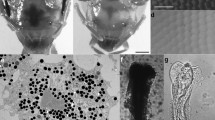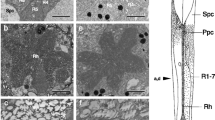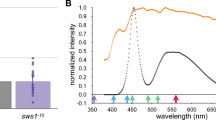Summary
Drosophila have 3 simple eyes, ocelli, located on the vertex of the head, in addition to 2 compound eyes. We determined ocellar function using the electroretinogram (ERG) and vision mutants.
The ERG waveform in response to a 1 s stimulus was a slow negative (receptor depolarizing) potential followed by a return to baseline at light-off (Fig. 1). During long stimuli there was an exponential decay to baseline after the initial negative deflection. At light-off there was a positive overshoot and return to baseline (Fig. 2). During a long stimulus the ERG reflected stepwise changes in intensity, with a negative response to an increase in intensity and positive polarization to a decrease (Fig. 3). The ERG thus reflects extraction of intensity change information.
The ocellar ERG waveforms (Fig. 4) and intensity-response functions (Fig. 5) were similar across wavelengths ranging from 370 to 520 nm. The ocellar spectral sensitivity peaks around 350–370 nm (ultraviolet) and 445 nm (blue) (Fig. 6). Chromatic adaptation with intense 370 or 445 nm did not selectively reduce 370 or 445 nm peak sensitivities (Fig. 7). These findings offer no support for more than one ocellar receptor type.
In additional experiments, bright 570 nm adaptation was found to increase responsivity relative to bright short wavelength adaptation. These wavelength-specific effects were elicited even during anoxia suggesting wavelength-dependent photopigment interconversions (Fig. 8). Spectral adaptation data were obtained suggesting that ocelli have a stable (non-bleaching) metarhodopsin. Spectral adaptation and sensitivity data allowed an approximation of the metarhodopsin spectrum which has long wavelength and ultraviolet maxima (Fig. 7).
Comparisons between the ERG waveforms and spectral sensitivities of normal and visual mutantDrosophila suggest that the absence of compound eye receptor types has no effect on the ocellar ERG. Also, strains with or without screening pigments do not show significant differences. However, 2 mutants with abnormal compound eye receptor potentials had ocellar abnormalities.
Similar content being viewed by others
Abbreviations
- PDA:
-
Prolonged Depolarizing Afterpotential
References
Bozler, E.: Experimentelle Untersuchungen über die Funktion der Stirnaugen der Insekten. Z. vergl. Physiol.3, 145–182 (1926)
Burkhardt, D.: Spectral sensitivity and other response characteristics of single visual cells in the arthropod eye. Symp. Exp. Biol.16, 86–109 (1962)
Burkhardt, D.: On the vision of insects. J. comp. Physiol.120, 33–50 (1977)
Chappell, R.L., DeVoe, R.D.: Action spectra and chromatic mechanisms of cells in the median ocelli of dragonflies. J. gen. Physiol.65, 399–419 (1975)
Chappell, R.L., Dowling, J.E.: Neural organization of the median ocellus of the dragonfly. I. Intracellular electrical activity. J. gen. Physiol.60, 121–147 (1972)
Cosens, D.J., Manning, A.: Abnormal electroretinogram from aDrosophila mutant. Nature224, 285–287 (1969)
Doane, W.W.:Drosophila. In: Methods in developmental biology (ed. F.H. Wilt, N.K. Wessels). New York: Thomas Crowell Co. 1967
Dowling, J.E., Chappell, R.L.: Neural organization of the median ocellus of the dragonfly. II. Synaptic structure. J. gen. Physiol.60, 148–165 (1972)
Eaton, J.L.: Spectral sensitivity of the ocelli of the adult cabbage looper moth,Trichoplusia ni. J. comp. Physiol.109, 17–24 (1976)
Ebrey, T., Honig, B.: New wavelength dependent visual pigment nomograms. Vision Res.17, 147–151 (1977)
Fischbach, K.F., Reichert, H.: Interactions of visual subsystems inDrosophila melanogaster: A behavioural genetic analysis. In: Biology of behaviour (in press)
Goldsmith, T.H.: Do flies have a red receptor? J. gen. Physiol.49, 265–287 (1965)
Goldsmith, T.H., Ruck, P.R.: The spectral sensitivities of the dorsal ocelli of cockroaches and honeybees. J. gen. Physiol.41, 1171–1185 (1958)
Goodman, L.J.: The structure and function of the insect dorsal ocellus. Advanc. Insect Physiol.7, 97–195 (1970)
Goodman, L.J.: The neural organization and physiology of the insect dorsal ocellus. In: The compound eye and vision of insects (ed. G.A. Horridge), pp. 515–548. Oxford: Clarendon Press 1974
Hamdorf, K., Rosner, G.: Adaptation und Photoregeneration im Fliegenauge. J. comp. Physiol.86, 281–292 (1973)
Harris, W.A., Stark, W.S.: Hereditary retinal degeneration inDrosophila melanogaster: a mutant defect associated with the phototransduction process. J. gen. Physiol.69, 261–291 (1977)
Harris, W.A., Stark, W.S., Walker, J.A.: Genetic dissection of the photoreceptor system in the compound eye ofDrosophila melanogaster. J. Physiol.256, 415–439 (1976)
Heisenberg, M.: Separation of receptor and lamina potentials in the electroretinogram of normal and mutantDrosophila. J. exp. Biol.55, 85–100 (1971)
Heisenberg, M., Buchner, E.: The role of retinula cell types in visual behavior ofDrosophila melanogaster. J. comp. Physiol.117, 127–162 (1977)
Hoyle, G.: Functioning of the insect ocellar nerve. J. exp. Biol.32, 397–407 (1955)
Hu, K.G., Reichert, H., Stark, W.S.:Drosophila ocelli. In: American association for the advancement of science meeting. Abstract 1978a
Hu, K.G., Reichert, H., Stark, W.S.: Electrophysiological characterization ofDrosophila ocelli. In: ARVO 1978: Invest Ophth. and Visual Sci. Suppl. pp. 195–196. Abstract 1978b
Hu, K.G., Stark, W.S.: Specific receptor input into spectral preference inDrosophila. J. comp. Physiol.121, 241–252 (1977)
Kirschfeld, K., Franceschini, N., Minke, B.: Evidence for a sensitizing pigment in fly photoreceptors. Nature269, 386–390 (1977)
Kirschfeld, K., Lutz, B.: The spectral sensitivity of the ocelli ofCalliphora (Diptera). Z. Naturforsch.32c, 439–441 (1977)
Labhart, T.: Electrophysiological recordings from the lateral ocelli ofDrosophila. Naturwissenschaften64, 99–100 (1977)
Lindsley, D.L., Grell, E.H.: Genetic variation ofDrosophila melanogaster. Carnegie Institution of Washington, Publication No. 627 (1968)
Médioni, J.: Mise en évidence et évaluation d'un “effet de stimulation” dû aux ocelles frontaux dans le phototropisme deDrosophila melanogaster Meigen. Compt. Rendus Soc. Biol.153, 1587–1590 (1959a)
Médioni, J.: Les organes de stimulation photique chezDrosophila melanogaster. Non-spécificité de cette stimulation relativement aux reactions à la lumière. Compt. Rendus Soc. Biol.153, 1845–1847 (1959b)
Metschl, N.: Electrophysiologische Untersuchungen an den Ocellen vonCalliphora. Z. vergl. Physiol.47, 230–255 (1963)
Mimura, K., Tateda, H., Morita, H., Kuwabara, M.: Regulation of insect brain excitability by ocellus. Z. vergl. Physiol.62, 383–394 (1969)
Minke, B., Wu, C.-F., Pak, W.L.: Induction of photoreceptor voltage noise in the dark inDrosophila mutant. Nature258, 84–87 (1975a)
Minke, B., Wu, C.-F., Pak, W.L.: Isolation of light induced response of the central retinula cells from the electroretinogram ofDrosophila. J. comp. Physiol.98, 345–355 (1975b)
Naka, K.I., Rushton, W.A.H.: An attempt to analyze colour reception by electrophysiology. J. Physiol.185, 556–586 (1966)
Pak, W.L., Grossfield, J., White, N.V.: Nonphototactic mutants in a study of vision ofDrosophila. Nature222, 351–354 (1969)
Pak, W.L., Pinto, L.: Genetic approach to the study of the nervous system. Ann. Rev. Biophys. Bioengineering5, 397–448 (1976)
Patterson, J.A., Goodman, L.J.: Intracellular responses of receptor cells and second-order cells in the desert locust,Schistocerca gregaria. J. comp. Physiol.95, 237–250 (1974)
Poggio, T., Reichardt, W.: Visual control of orientation behaviour in the fly. Part II. Towards the underlying neural interactions. Quart. Rev. Biophys.9, 377–438 (1976)
Razmjoo, S., Hamdorf, K.: Visual sensitivity and the variation of total photopigment content in the blowfly photoreceptor membrane. J. comp. Physiol.105, 279–286 (1976)
Reichardt, W., Poggio, T.: Visual control of orientation behaviour in the fly. Part 1. A quantitative analysis. Quart. Rev. Biophys.9, 311–375 (1976)
Ruck, P.: Electrophysiology of the insect dorsal ocellus. I. Origin of the components of the electroretinogram. J. gen. Physiol.44, 605–627 (1961)
Schmidt, B.: Die neuronale Organisation in den Ocellen vonDrosophila. Thesis, Freiburg 1975
Stark, W.S.: Spectral selectivity of visual response alterations mediated by interconversions of native and intermediate photopigments inDrosophila. J. comp. Physiol.96, 343–356 (1975)
Stark, W.S.: Sensitivity and adaptation in R7, an ultraviolet photoreceptor, in theDrosophila retina. J. comp. Physiol.115, 47–59 (1977)
Stark, W.S., Ivanyshyn, A.M., Greenberg, R.M.: Sensitivity and photopigments of R1-6, a two-peaked photoreceptor, inDrosophila, Calliphora andMusca. J. comp. Physiol.121, 241–252 (1977)
Stark, W.S., Ivanyshyn, A., Hu, K.G.: Spectral sensitivities and photopigments in adaptation of fly visual receptors. Naturwissenschaften63, 513–518 (1976)
Stark, W.S., Wasserman, G.S.: Wavelength-specific ERG characteristics of pigmented- and white-eyed strains ofDrosophila. J. comp. Physiol.91, 427–441 (1974)
Stark, W.S., Zitzmann, W.G.: Isolation of adaptation mechanisms and photopigment spectra by vitamin A deprivation inDrosophila. J. comp. Physiol.105, 15–27 (1976)
Stavenga, D.G., Zantema, A., Kuiper, J.W.: Rhodopsin processes and the function of the pupil mechanism in flies. In: Biochemistry and physiology of visual pigments (ed. H. Langer). Berlin-Heidelberg-New York: Springer 1973
Toh, Y., Tominaga, Y., Kuwabara, M.: The fine structure of the dorsal ocellus of the fleshfly. J. Electron Microsc.20, 56–65 (1971)
Tsukahara, Y., Horridge, G.A.: Visual pigment spectra from sensitivity measurements after chromatic adaptation of single dronefly retinula cells. J. comp. Physiol.114, 233–251 (1977)
Vogt, M.: Response of the imaginal discs to experimental defects,Drosophila. Biol. Zbl.65, 223–238 (1946)
Wong, F., Wu, C.-F., Mauro, A., Pak, W.L.: Persistence of prolonged light-induced conductance change in arthropod photoreceptors on recovery from anoxia. Nature264, 661–664 (1976)
Author information
Authors and Affiliations
Additional information
Supported by Die Studienstiftung des deutschen Volkes and SFB 46 to H.R. and NSF Grant BNS 76-11921 to W.S.
We thank R. Chappell and R. DeVoe for their critical reviews of the manuscript. We also thank H. Broda, H. Brownell, M. Johnson, T. Labhart, A. Shearn, H.Ch. Spatz, H. Weaver and C.-F. Wu for assistance.
Rights and permissions
About this article
Cite this article
Hu, K.G., Reichert, H. & Stark, W.S. Electrophysiological characterization ofDrosophila ocelli. J. Comp. Physiol. 126, 15–24 (1978). https://doi.org/10.1007/BF01342646
Accepted:
Issue Date:
DOI: https://doi.org/10.1007/BF01342646




